Physiotherapy treatment as part of a multidisciplinary team (MDT) approach is of benefit in physical rehabilitation of feline patients (Sharp, 2012; Vigor Craigie Halkett and Romano, 2017). Physiotherapy is useful in treating chronic conditions such as osteoarthritis (OA) (Bockstahler at al, 2004; Slingerland et al, 2004), or as a supportive treatment pre operatively and post operatively, such as in cases of cruciate or patella fixation or, more commonly in cats, cases of fracture repair and spinal surgery (Scott et al, 2007; Harasen, 2008).
From the authors' perspective, a multidisciplinary team approach (incorporating various professionals such as physiotherapists, acupuncturists, McTimoney practitioners and hydrotherapists) could be more effective for the management of OA in cats compared with the use of single modalities. The composition of the team in any individual centre will vary, but emphasis should be placed on the tasks required to care for the individual patient's needs, with the aim of minimising the impact of the disease. This combined approach brings together the skills and knowledge of all team members, for both the assessment and management of disease, but requires a high level of communication and cooperation (The National Institute for Health and Care Excellence (NICE), 2009).
Working with an integrated approach it is possible to achieve recovery and functional mobility in a shorter time. According to the knowledge gained by studies and clinical experience of the authors, while physiotherapy can work on joint mobilisation and the relief of muscular trigger points (TP), acupuncture could be effective in managing tension in the muscular fascia and relieving pain, while hydrotherapy acts to strengthen the muscles, increase mass and reduce muscle tension.
Acupuncture
Acupuncture belongs to an ancient tradition of Chinese medicine (TCM) which originated in ancient China, and has evolved over thousands of years. TCM practitioners use acupuncture and many other techniques to achieve a complementary approach to resolving the problem, such as the use of herbs, dietary therapy or Tuina (Chinese therapeutic massage) (National Center for Complementary and Integrative Health (NCCIH), 2013).
As in human practice, veterinary acupuncture is defined as the insertion of needles into specific points on the body surface to produce a healing response. According to the International Veterinary Acupuncture Society, and most of the acupuncture societies for humans, such as the British Medical Acupuncture Society and the British Acupuncture Council, this practice is indicated for paralysis, inflammation and pain (Lin et al, 2017).
In small animals, the main conditions treated with acupuncture are: musculoskeletal problems, OA, intervertebral disc disease or traumatic nerve injury, respiratory problems such as feline asthma, or skin problems such as allergic dermatitis or psychogenic alopecia in cats (Shoen, 2001). Although acupuncture has its roots in ancient times before modern scientific methods were available with which to study it, many important studies have been carried out to indicate how acupuncture works and what physiologic mechanisms are involved in its action. From the neurophysiologic point of view, studies have shown that the effects of acupuncture are, at least in part, mediated by a cascade of endorphins and monoamines changing conduction in the central nervous system. Stimulation of acupoints has pain relieving properties associated with activation of specific pain-associated brainstem areas (Figures 1–3). To achieve such a stimulation, other related techniques, such as electroacupuncture (EA), laser-acupuncture or acupressure, are often used instead of needles (Habacher et al, 2006).
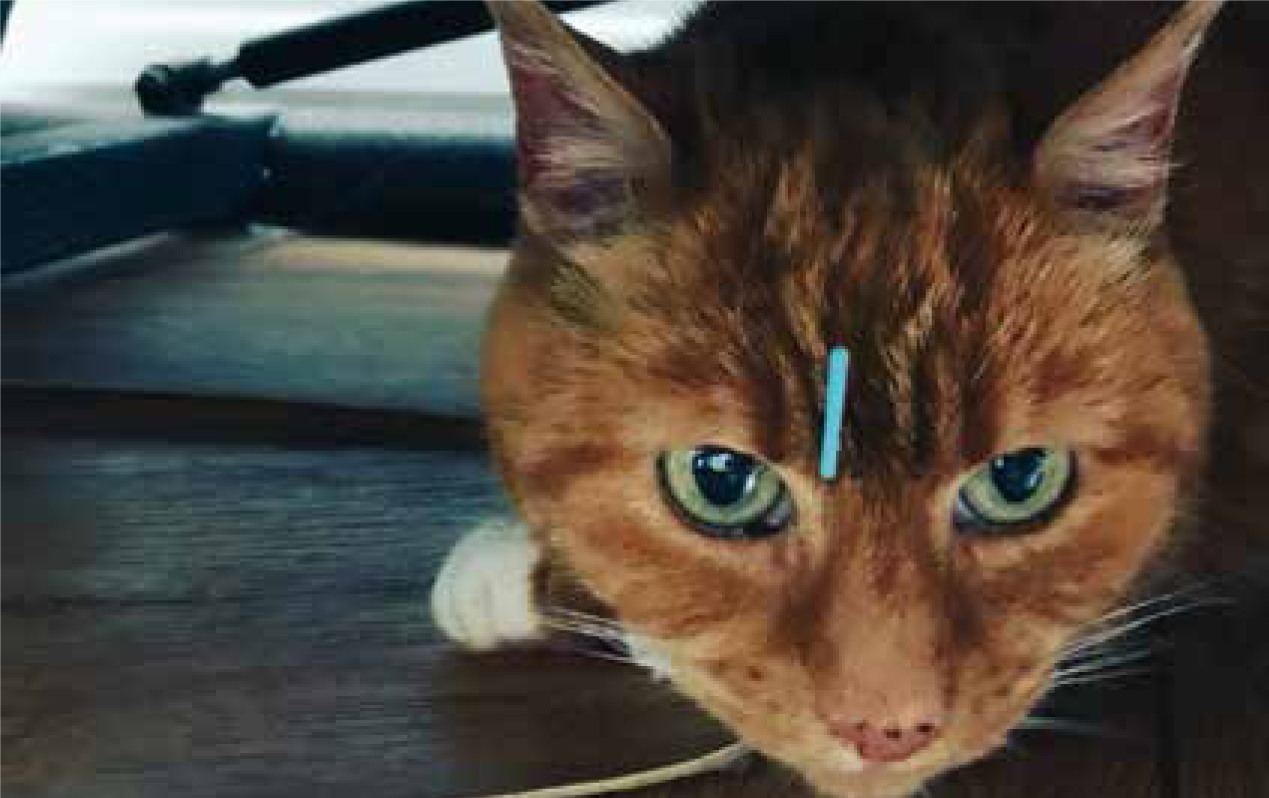
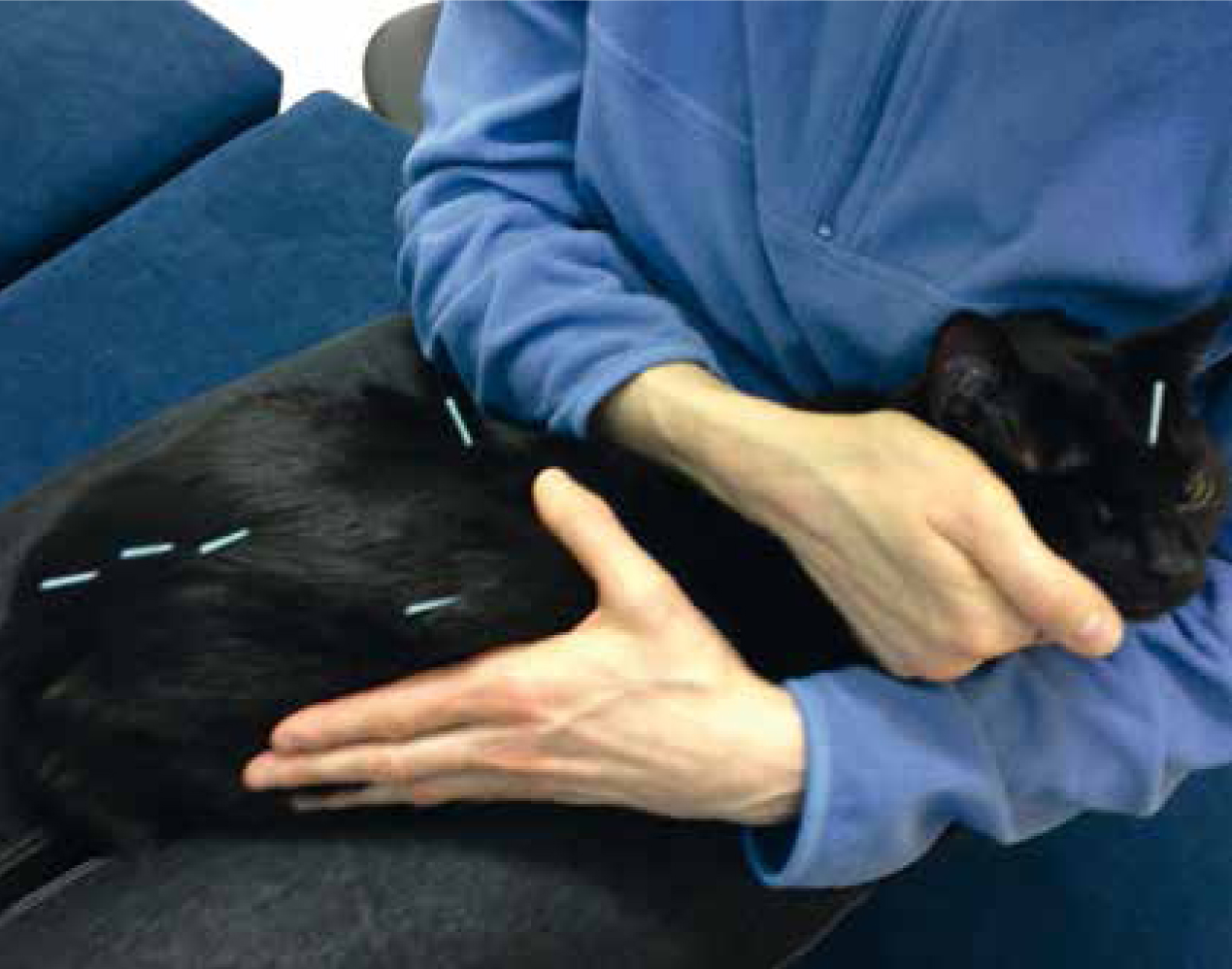
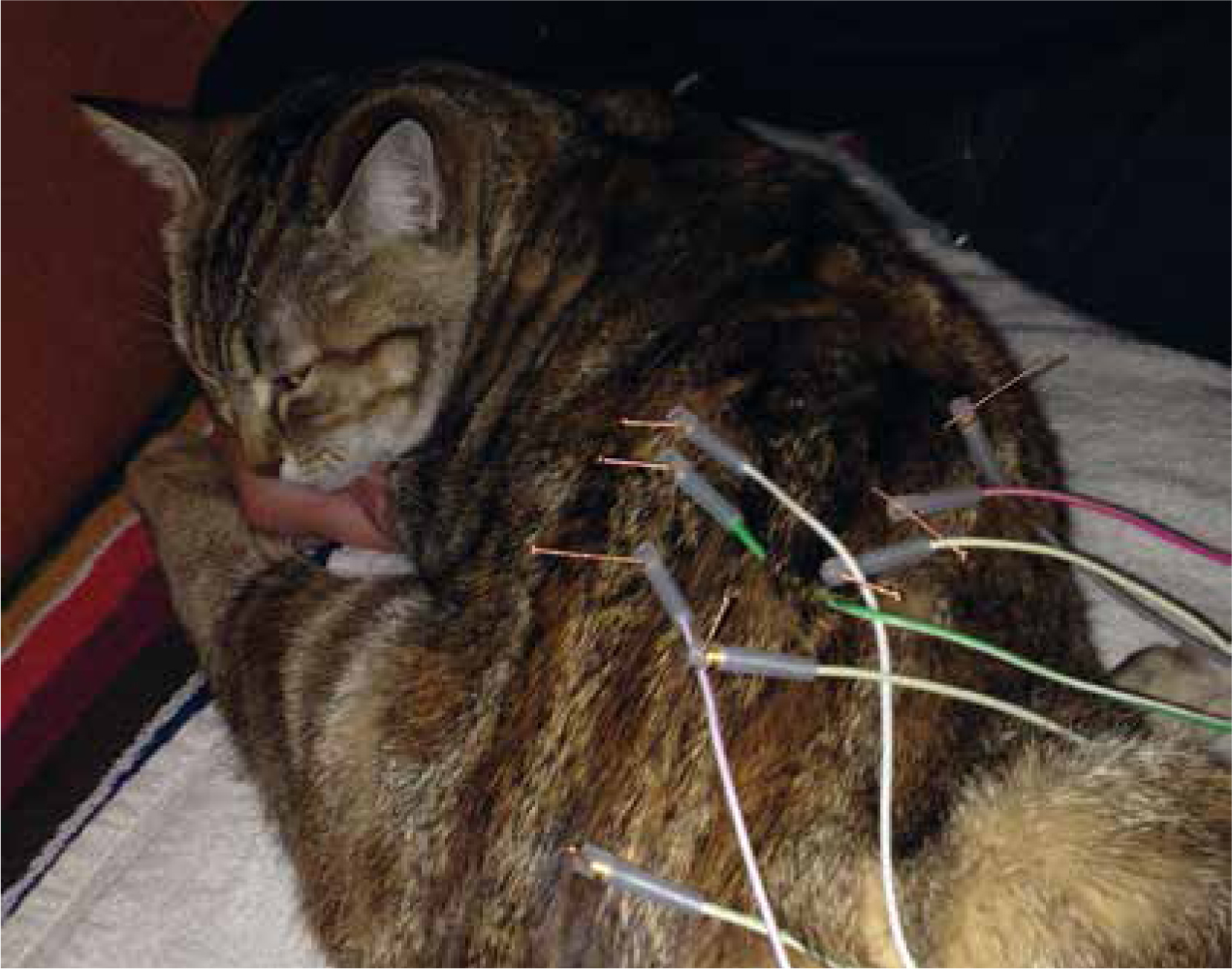
According to the concepts of Western medicine, acupuncture can assist the body to heal itself by affecting certain physiological changes, such as increasing blood circulation or stimulating nerves, relieving muscles and muscular fascia spasm and releasing hormones such endorphins (one of the body's pain control chemicals) and cortisol (a natural steroid) (Cheng, 2014). The Traditional Chinese medicine describes the practice of acupuncture as stimulating Chi meridians and removing blockages so that energy can move freely through the body (Limehouse et al, 2001)
Needles used to practice acupuncture are thin stainlesssteel mono-use needles that make the insertion virtually painless. On clinically-based evidence and experience of one of the authors, most animals become very relaxed and may even fallen asleep following insertion of the needles. Nevertheless, acupuncture treatment may cause some sensations, presumed to be a tingle or prickly sensation, slight cramps or numbness, which are known to occasionally occur in humans and may be uncomfortable to some animals (Shoen, 2001).
When treating cats, it is recommended to use acupoints with sedative action which have been shown to release higher amounts of endorphins to start with, in order to relax the patient as much as possible. Some cats react better to Tuina massage on such points compared with others that react better to needles, but as every cat is different it is fundamental to adjust the treatment according to each individual patient (Table 1).
| Techniques | Actions | Indications |
|---|---|---|
|
Yi-zhi-chan
|
Regulates and promotes the energy flow and smooths the tendons | Several areas of the body, usually the neck, chest, abdomen and limbs |
|
Gun-fa
|
Increases the blood circulation, smooths tendons and joints, warm the meridians | Pain in the shoulders, trunk, back and limbs, areas with thick muscles, Bi Syndrome, numbness in the limbs, hemiplegia, obstruction of joint movement |
|
Rou-fa
|
Increases the blood circulation, resolves swelling and relieves pain | Different areas of the body to harmonise other Tuina techniques and pain patterns |
|
Ca-fa
|
Tonifies and unblocks meridians | Treats internal organ disorders, patterns with abdominal and lumbar pain |
|
Tui-fa
|
Relaxes the tendons, dissipates local stagnation, excites the muscles and improves the blood circulation | Various part of the body, Bi Syndrome, local blood stagnation and internal organ disorders |
|
An-fa
|
Invigorates the blood circulation and unblocks obstruction on the meridians | Whole body, sore areas, painful joints |
|
Dian-fa
|
Invigorates blood, relieves pain and balances organ functions | Acupuncture points near bones and thick muscles, such as the gluteus, and lower limbs and acute pain syndromes |
|
Nie-fa
|
Invigorates the blood circulation | Superficial tissue such as the head, neck, limbs and epaxial muscles areas of the spine, commonly used in geriatrics |
|
Ji-fa
|
Regulates blood flow, extends the tendons | Numbness in the limbs, neck and back due to inter vertebral disc disease (IVDD) and muscle spasm |
|
Ba-shen-fa
|
Stretches the tendons | Malposition of the joints and injured tendons |
According to the experience of one of the authors, most cats tolerate acupuncture treatment very well. However, if a cat appears stressed by manipulation or massage it is recommended not to stress the animal any further and to instruct the owner on how to carry out digitopressure at home in order to help reduce stress in the cat prior to a visit to the physiotherapist or veterinary surgeon. Digitopressure is a form of acupressure performed using the finger pressure on the body surface. Acupressure is one of the oldest methods of stimulating acupuncture points used by classic Chinese therapists (Altman, 2001).
Acupuncture points for cats exist throughout the musculoskeletal system, along the spine, front and hind limbs, near all the major joints and around the head. See Table 2 for specific feline acupuncture locations.
| Acupoints | Location | Indications |
|---|---|---|
| YINTANG | In the depression on the dorsal midline of the head, between the eyes on the upper border of the eye | Anxiety |
| LI 4 | In the depression between the 1st and 2nd metacarpal bones in the middle of the 2nd metacarpal bone on the radial side (medial) | Pain in general, head, cervical, neck, shoulder and forelimb pain, paralysis or atrophy of the forelimb |
| LI 10 | In the muscular groove between the extensor carpi radialis and the common digital extensor close to the transverse cubital crease on the lateral side of the forelimb | Pain and stiffness in the forelimb, shoulder and neck pain, atrophy and radial nerve paralysis of the forelimb |
| PC 6 | In the depression proximal to the transverse crease of the medial side of the carpus, between the tendon of the flexor digitorum superficialis and the flexor carpi radialis | Pain in general, relaxing the mind |
| ST 36 | In the depression lateral to the tibial crest approximately in the middle of the cranial tibialis muscle | Pain and stifle problems, general hindlimb stiffness, tibial and fibular nerve paralysis |
| GB 34 | In the depression cranial and distal to the head of the fibula on the lateral side of the forelimb | Tendonitis, hindlimb pain and weakness, stifle problems, paralysis of the tibial and fibular nerve |
| BL 60 | In the middle of the depression cranial to the tuber calcanei | Hock and back problems, weakness and/or paralysis of the hindlimbs |
| BAIHUI | In the depression on the dorsal midline in the lumbosacral space | Sciatica, hindlimb paralysis or paresis, lumbosacral pain and disc disease |
According to the WHO standard acupuncture nomenclature (1993): LI 4 is the 4th point on large intestine (LI) meridian; LI 10 is the 10th point on large intestine (LI) meridian; PC 6 is the 6th point on pericardium (PC) meridian; ST 36 is the 36th point on stomach (ST) meridian; GB 34 is the 34th point on gallbladder (GB) meridian; BL 60 is the 60th point on bladder (BL) meridian; YINTANG and lumbar BAIHUI are extra points not located on a meridian
According to the clinical experience one of the authors, some cats also tolerate well a modern Chinese procedure called electroacupuncture. This technique is defined by the delivery of electrical energy through acupuncture points using a medical electronic device directly connected to the needles inserted in the skin. Electroacupuncture could provide an accurate, uniform and objective stimulation of the needles and can produce a higher level of stimulation than the manual technique where needles are placed without electrical stimulation (Han, 2003).
The diagram in Figure 4 represents a simplification of the possible acupuncture mechanism highlighted by a pioneering discovery in modern acupuncture research. Cheng (2014) reviewed previously proposed neurobiological mechanisms of how acupuncture could work and the relative efficacy for different clinical conditions. Microinjury provoked by the needle puncture facilitates local healing increasing the blood flow into musculoskeletal problems and stimulating axon reflexes. The acupuncture stimulation could interrupt the pain pathway and the concomitant intramuscular stimulation releases the muscle shortening.
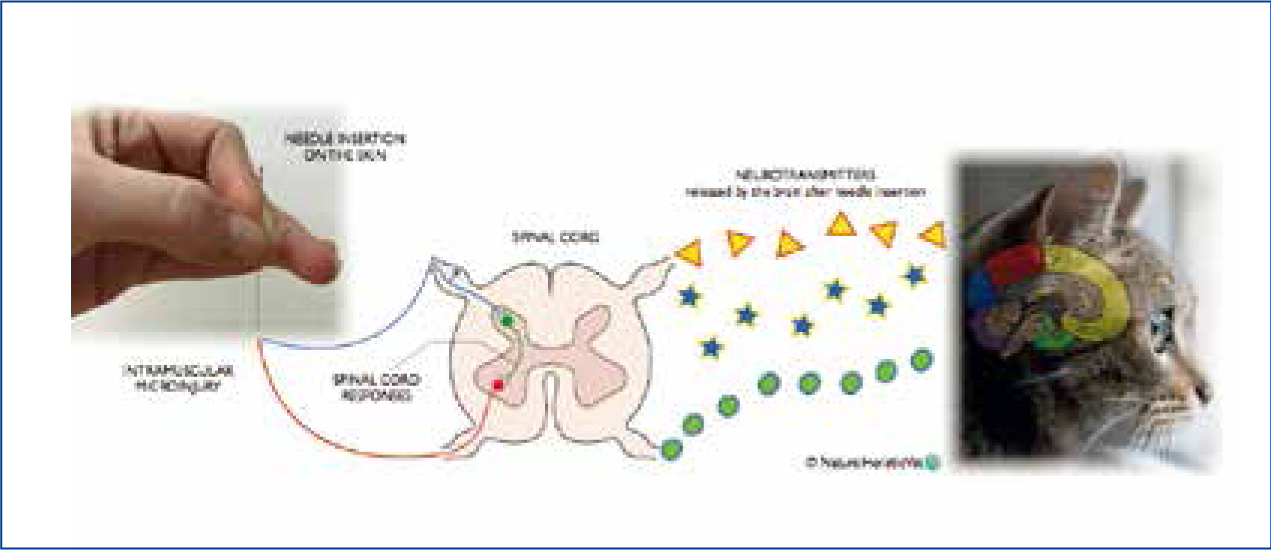
Acupuncture may also change the levels of some neurotransmitters, such as serotonin and dopamine, and other pain-modulating neurotransmitters, such as met-enkephalin and substance P along the nociceptive pathway (Cheng, 2014).
Hydrotherapy
Cats' aversion to water is widely accepted as fact, but not all cats respond in a negative way to getting wet. Therefore, hydrotherapy should be considered as part of the rehabilitation programme for cats (Figure 5).
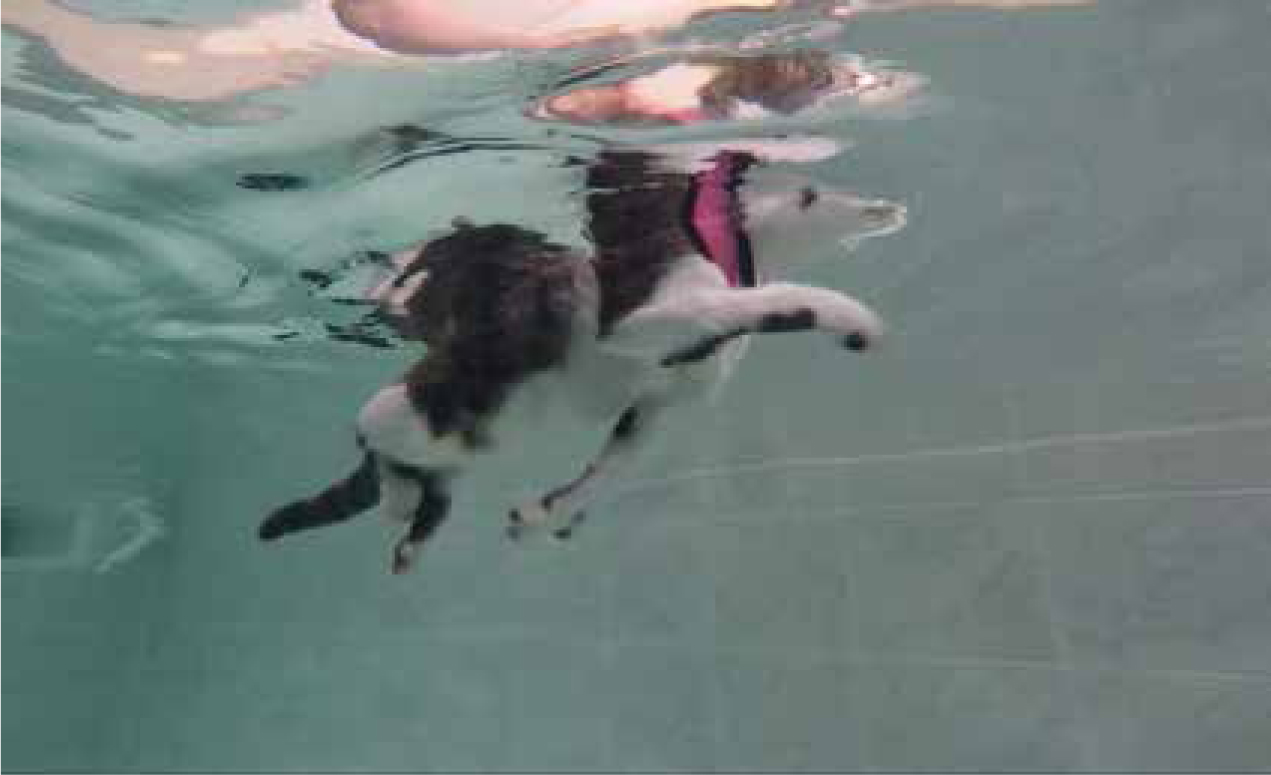
Many cats with ancestors coming from hot and arid areas or lake and mountain areas, such as the Turkish Van cat, regularly swim and bath to stay cool, or catch food (e.g. the Asian fishing cat) (Lushington, 1963). Gentle introduction to hydrotherapy for cats can be successful both when using a hydro pool or a water-based treadmill (Figure 6).
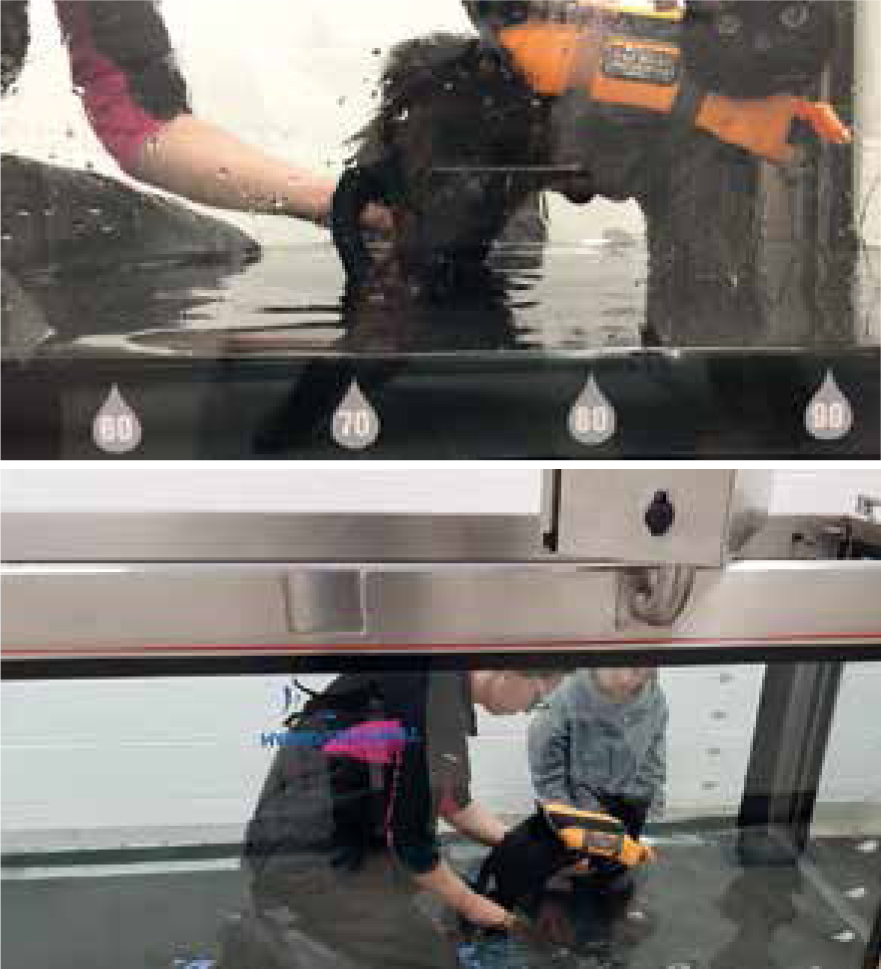
The natural properties of the water, such as buoyancy, create a suitable environment for performing non-concussive active exercise, which helps to relieve pain, reduce swelling and stiffness, improve blood circulation, improve limb mobility, muscle strength and range of motion as Jackson et al (2002) observed. Warm water increases the circulation of blood to the muscles, increasing the supply of oxygen and nutrients, leading to muscle relaxation and reducing pain and stiffness. Improved circulation reduces swelling around an injured area and enhances healing. The buoyancy effect of water reduces the load on weight bearing joints, which helps to reduce pain and allows easier movement and exercise. In a study of dogs, the amount of bodyweight borne when immersed in water (as a percentage of bodyweight on dry ground) was approximately 91% with the water at the level of the lateral malleolus of the tibia, 85% at the level of the lateral condyle of the femur, and 38% at the level of the greater trochanter of the femur (Levine et al, 2002). This type of information is useful when treating patients with joint conditions such as arthritis because the joints can be unloaded using the properties of buoyancy in the water. Hydrostatic pressure, applied to the cat's body in water, can assist in reducing swelling; and as the pressure increases with depth this encourages inflammatory fluids in the limbs to move away from affected areas which are immersed lower in the water, back towards the body. Buoyancy and hydrostatic pressure also help to support the feline body during exercise and this can also assist in re-education of the gait patterns in neurological conditions, and confidence and ability to reload a limb post surgery.
Extensive work in human physiotherapy has demonstrated that a monitored course of hydrotherapy sessions gradually encourages a full range of joint motion in reduced weight bearing conditions, thus improving muscle tone and promoting tissue repair, without imposing stress on damaged tissues (Barker et al, 2014). Controlled swimming helps to improve cardiovascular stamina, muscle tone, range of movement and is particularly helpful in aiding recovery from injury or surgery. Muscle wastage begins soon after any immobilisation, so to prevent further weakness or injury it is important to rebuild, through safe exercise, any muscles that have deteriorated (Michel et al, 2011). Movement in water is more difficult than on land due to the resistance of the water. Water-based exercise uses 30% more oxygen than similar land-based exercise. By encouraging pain-free limb movement against the resistance of water, muscle mass will increase and thus muscle wastage will be reversed. Hydrotherapy can be performed in either a pool or aquatic treadmill depending on the goals the hydrotherapist wants to achieve and the problem being treated. A range of conditions in the cat may benefit from hydrotherapy including some postoperative fractures, neurologic conditions, tendonitis, OA and muscle atrophy. Contraindications to water-based therapy would include open wounds and cats carrying infections. It is recommended that sutures or staples are healed and removed prior to hydrotherapy to minimise the risk of wound breakdown. The cardiovascular health of a patient is also of significance when referring for hydrotherapy and the appropriate modality. Therefore, a good detailed referral and open communication between the referring veterinary surgeon and the rehabilitation practitioner is essential in the correct treatment and management of the patient.
Referral for acupuncture and hydrotherapy
When referring to a veterinary acupuncturist the practitioner should ensure that the professional employed is a registered veterinary surgeon and that they are also registered with the Association of British Veterinary Acupuncturists (ABVA).
When referring to a hydrotherapist or hydrotherapy centre the professional should have undertaken a minimum level 3 Certificate in Hydrotherapy at an accredited centre or hold a relevant professional physiotherapy degree which has included hydrotherapy in its course. It is vital that the professional or centre is also registered with the Canine Hydrotherapy Association (CHA) or the National Association of Registered Canine Hydrotherapist (NARCH). Both these associations take members who fulfil strict qualification and insurance requirements and who use correct referral methods and use treatment records. They also ensure that professional practices are adhered to and that water management is taken seriously in terms of multiple daily tests and the recording of findings, chemical management and maintenance of equipment. For clients wishing to claim their treatments through pet insurance, these memberships and training levels will be mandatory requirements for cover. It is important for clients wishing to claim for treatment that they check with their own policy and insurance company regarding cover and limits.
Conclusion
It can be concluded that both acupuncture and hydrotherapy should be considered as suitable forms of treatment for the feline patient across several diagnoses. Clear referral and the use of correctly qualified and registered practitioners are essential in the safe and responsible treatment of a patient. Overall, feline patients that are accepting of acupuncture or hydrotherapy generally do well and find the outcomes to be beneficial.

